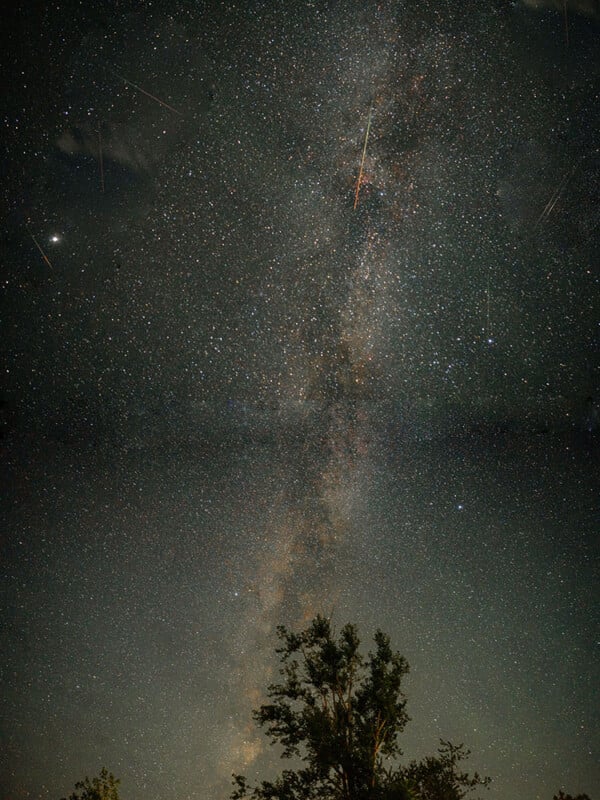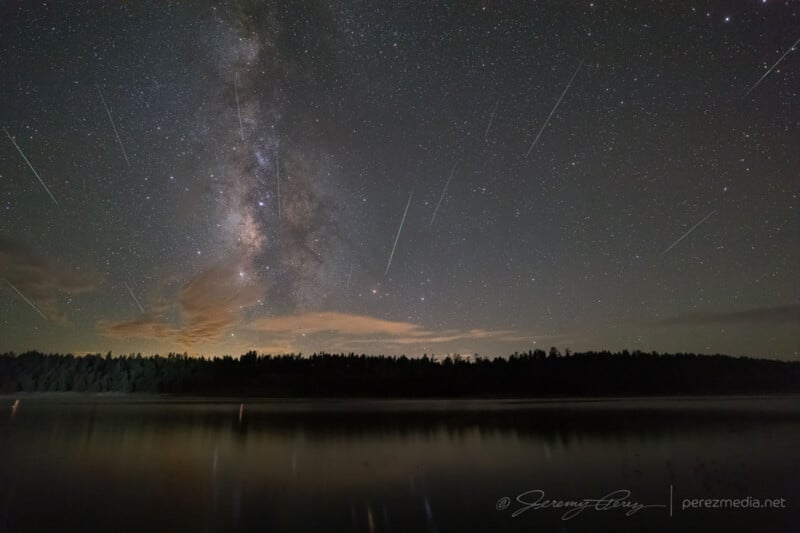The Best Photos From This Weekend’s Spectacular Perseids Meteor Shower
![]()
The Perseids meteor shower peaked this past weekend with photographers out in force capturing the annual cosmic show.
This year was a particularly good year for pictures since the Moon was only 10 percent illuminated during the peak of the meteor showers, the night of August 12.
Raghuvamsh Chavali was one of the photographers who headed out this weekend. Chavali went to Turkey Point on the shores of Lake Eerie with a Sony a7 III and captured 25 or so meteors between 23:30 and 04:30. He composited them into one incredible image.

“Seeing these shooting stars was like a treasure hunt, as they came from all directions,” Chavali tells PetaPixel.
“Some were quick blinks, while others left long trails behind, reminding me of how fleeting and beautiful life can be. I couldn’t help but think about the vastness of the universe as the meteor shower faded away.”
Bang
Photographer Christopher Sherman captured an explosive meteor on his camera set up north of Oelwein, Iowa. At nearly 02:00, a meteor shot into frame and exploded with Sherman capturing exquisite stills and video of it.
Witnessed several dozen Perseid Meteors last night but this large fireball at 1:58:58am made us jump. The camera recorded the debris movements for more than 7 minutes after it broke up. Time lapse north of Oelwein, Iowa #perseid #meteor #iawx #PerseidMeteorShower @spann #perseids pic.twitter.com/ogrKBLNKaW
— Christopher V. Sherman (@cvsherman) August 13, 2023
4 shots of that Perseid Meteor fireball this morning 1:58:58am. Watched debris fragment with the naked eye for a couple of minutes. The camera saw it for 7+ mins. F/2.8, iso 3200, 13 sec exp. North of Oelwein, Iowa #perseid #meteor #iawx #PerseidMeteorShower @spann #perseids pic.twitter.com/eaOZSVjHlQ
— Christopher V. Sherman (@cvsherman) August 13, 2023
Meanwhile, photographer Jeremy Perez, who recently captured a SpaceX rocket punching a hole in the atmosphere, composited 13 photos of the Perseids into a single image.

Somewhere near Maine and New Hampshire, Rob Wright captured a meteor that burned perfectly into his shot.
“Caught a huge, bright Perseids meteor this evening! Hard to believe it began and ended in the frame,” he writes.
Caught a huge, bright #Perseids meteor this evening! Hard to believe it began and ended in the frame. #PerseidsMeteorShower #perseids2023 pic.twitter.com/MCcyHNeCzY
— Rob Wright Images 🌻 (@RobWrightImages) August 14, 2023
Matt Lantz jokes that the only showers in Texas in August are meteor showers while sharing a magnificent photo of the fireballs above a church. While Jeff Boyce posted a solitary Perseids meteor above Yosemite National Park.
#Perseids meteor this morning in Yosemite pic.twitter.com/ShTeHgWxym
— Jeff Boyce (@Negative_Tilt) August 14, 2023
The Perseid Meteor Shower was a sight to see this morning!
This is a composite photo of about 12 stills that each had one meteor in them. I counted about 40 visible streaks during the hour I shot this morning. #PerseidMeteorShower #Perseids @JesseWFAA @AJamesMcCarthy pic.twitter.com/C8rZ17tOvi
— Matt Lantz (@mattlantz) August 14, 2023
As noted by Space, the Perseids happen when planet Earth passes through a debris field left behind by the Swift-Tuttle Comet. Earth passes through bits of ice and rocks each year on August 11 and 12. Less moonlight means more visible meteors.